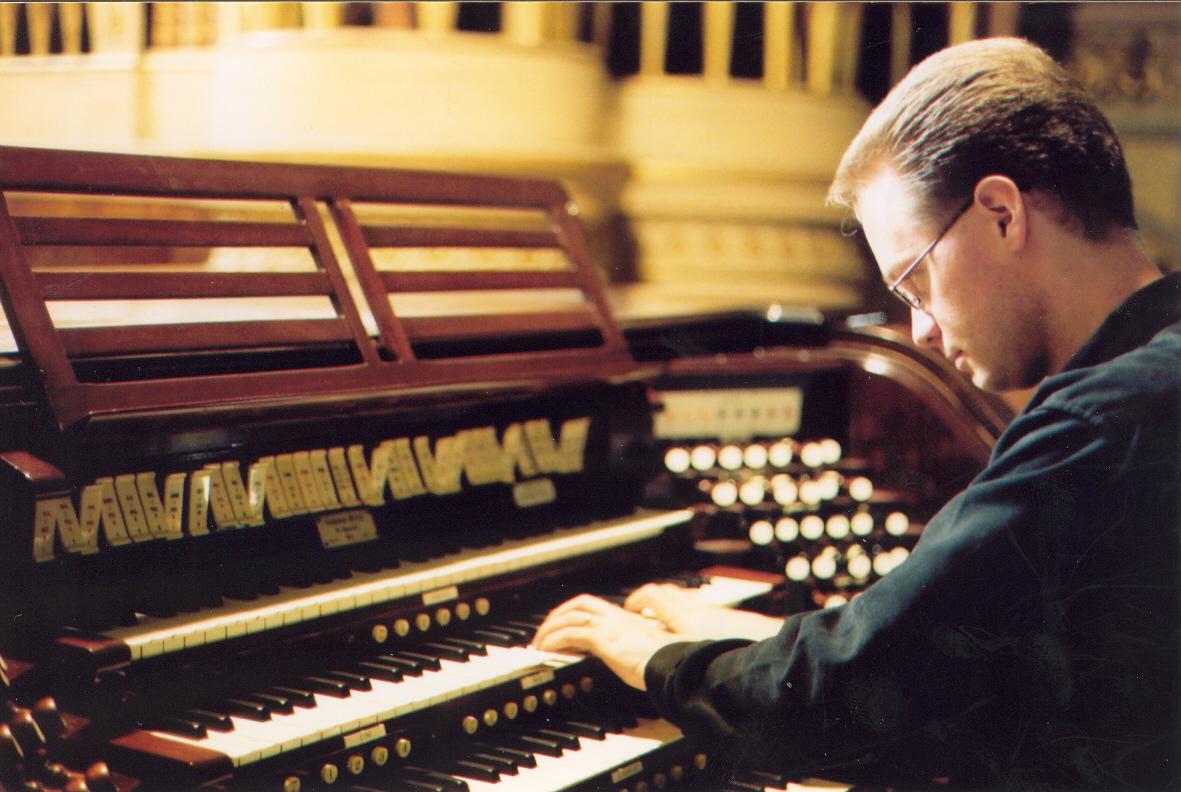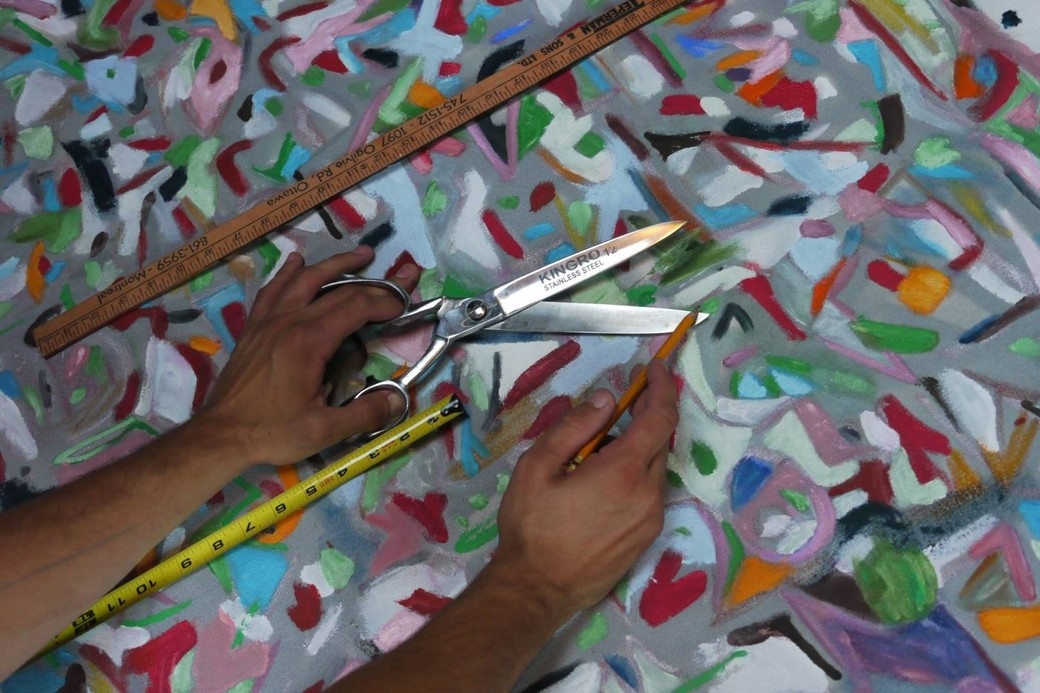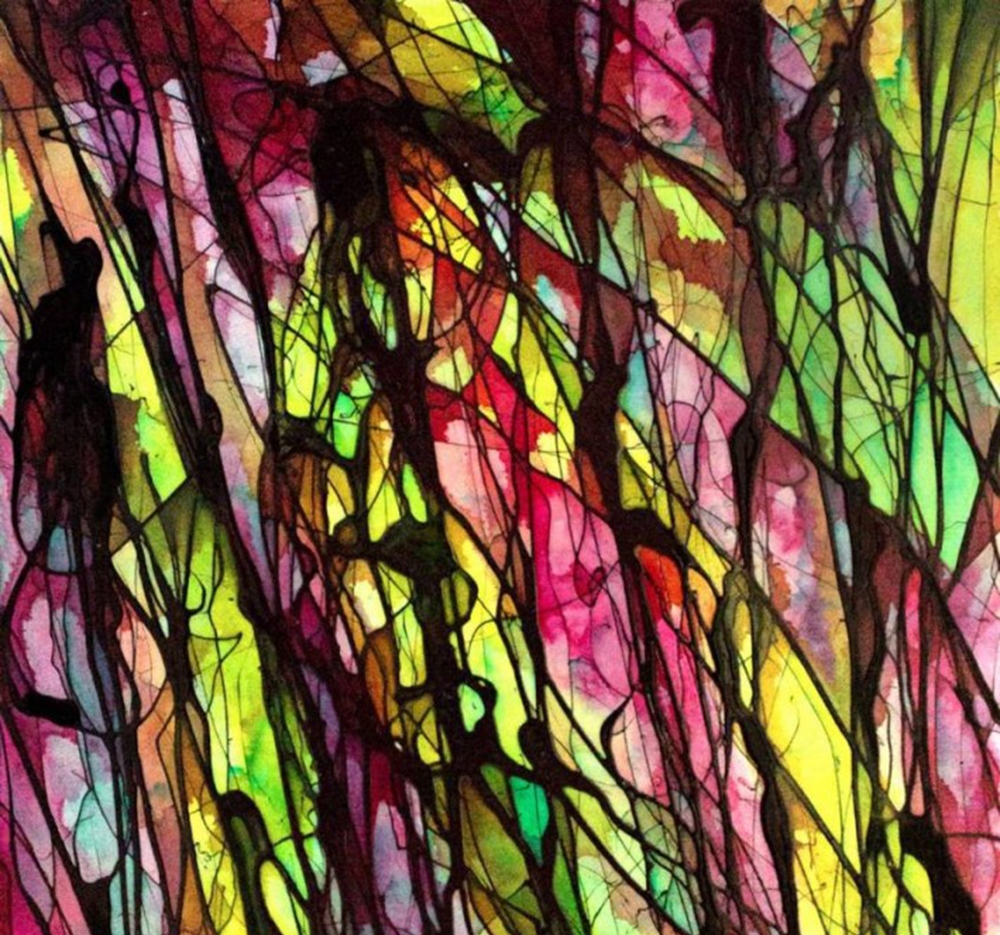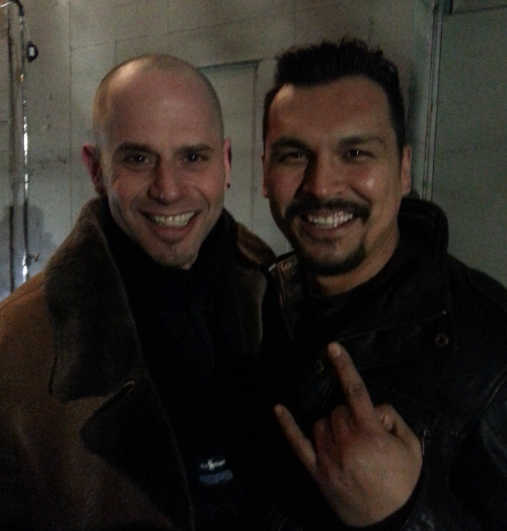
An Actor’s Life or How I Learned to Stop Worrying and Love Standing in an Alley in the Dead of Winter for 12 Straight Hours with only Linty Pocket Candy to Eat
Acting is nothing more or less than playing. The idea is to humanize life.
George Eliot
Acting deals with very delicate emotions. It is not putting up a mask. Each time an actor acts he does not hide; he exposes himself.
Rodney Dangerfield
For nearly 30 years of my life, I’ve had the good fortune and the opportunity to work as a so-called independent artist. I’ve worked as a full-time stand-up comic and professional actor. I’ve gotten to record and tour in a band, as well as work as a voice actor for several animation productions. And of course, the wonderfully encouraging folks at Ottawa Life Magazine have given me a platform on which to voice whatever musical and/or pop-cultural ramblings I may have on one topic or another. More importantly, these same lovely people have also kindly allowed me to take some time here and there to pursue my more cinematic interests. (Merci, Harvey! I owe you a “thank you” bunt cake!)
Some of you may have noticed that over the last few months, I haven’t been posting as much as I usually do, and perhaps some explanations are in order. My acting life has recently kept me more than extremely busy for one thing, and for those of you not familiar with the vagaries of choosing a life in the arts, re: “crapshoot”, the work always comes very much in the feast or famine variety – which is to say that it’s always best to take advantage of being busy because you never know when you won’t be. Over the last few months, almost every free moment I’ve had has gone into working on different TV, film and music projects. What I hope to do with the next few blogs is to provide some insight into what it’s like working on independent productions here in our beautiful nation’s capital. The first I’ll examine is a full-length feature-film release called Crook, written and directed by Ottawa’s own Adrian Langley. (http://www.imdb.com/name/nm1454995/)
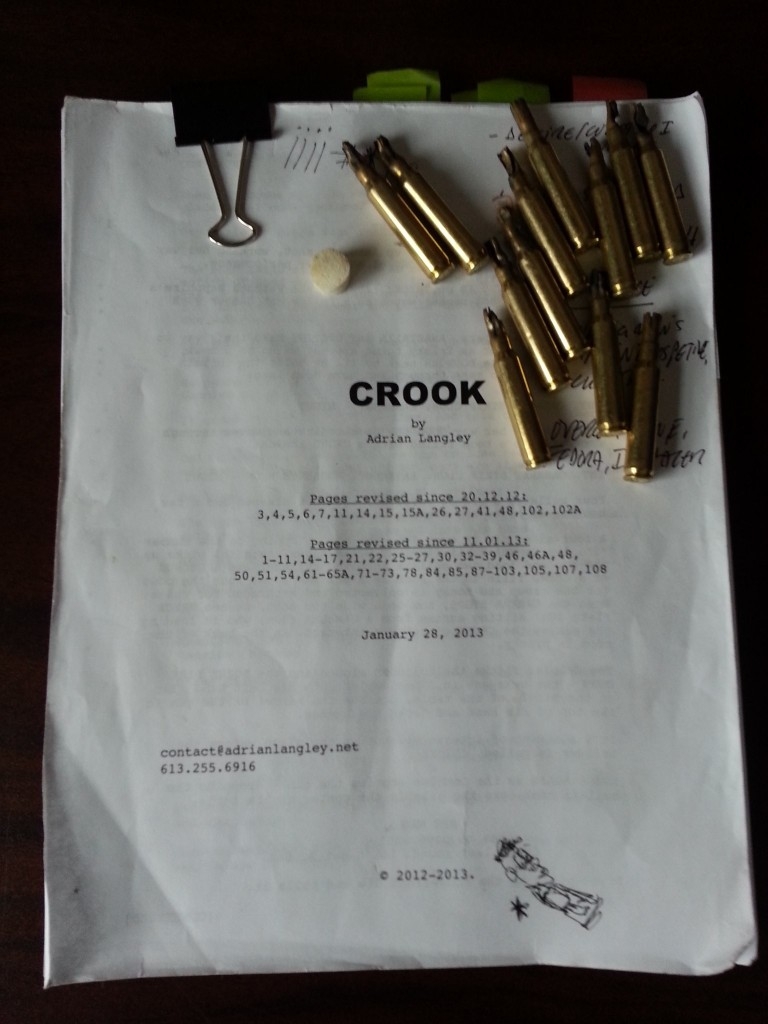
In other words, what exactly does go through your head as you spend 12 hours huddled under a urine-soaked underpass in an industrial complex, in minus 25 degree weather, running on nothing but some paradoxically lukewarm Rock Star energy drinks, some body-temperature ju-jubes nestled snugly in a co-actor’s linty pocket, and a pack of mint-flavoured floss you happened to find in the prop-car’s* glove box. Well, what goes through your head aside from third-degree frostbite, that is. Seriously. Frostbite literally through your head. That’s how cold it was. I think that might technically be called “head-bite” but I’d have to look it up. If it isn’t called “head-bite,” it damn well should be. I’m saying it was cold, people! So over the next few weeks, I’ll be talking about exactly what it is that I have been doing, and I hope that it makes for some entertaining reading.
I think most people would be surprised to know not only the number of film productions that shoot here in Ottawa, but that our city also has 300+ working actors. Literally tens of dozens of productions, big and small, shoot here over a given year. Check out some of them mentioned here in a recent Ottawa Sun article on Ottawa’s burgeoning movie industry: http://www.ottawasun.com/2013/03/10/ottawa-film-industry-growing
Ottawa is the perfect place to do it, if you think about it; we have pretty much any kind of “movie backdrop” you can think of, whether it be a beach, a farm, mountains, nightlife, industrial complexes, hotels, museums or restaurants, we’ve pretty much got it covered and more.
Crook was made through Langley’s Fluke Productions, in conjunction with Ottawa’s own Zed Filmworks– http://www.zedfilmworks.com/, a longstanding and prominent film-production house, and it is an achievement in filmmaking. As I’m sure most people know, big-screen movie budgets are measured in millions, and sometimes hundreds of millions of dollars, and the filming itself can extend for years in some cases. Crook was shot in 14 days, with a budget averaging out at around $50,000. That may surprise you to learn, but there have been several examples of movies shot on little or no budget, that ended up taking the film world by storm – The Blair Witch Project and Bottle Rocket, to name but two. In fact, most big-budget film directors get their start shooting anything and everything but feature films. Commercials, music videos, short subjects, anything they can get their hands on to hone and perfect their craft. My point is that there is not necessarily a correlation between how much something cost and how good it actually is. Ask Michael Bay. What makes or breaks a good movie, in my humble opinion, is story, plain and simple. And Langley seems to go to great pains to try to craft as interesting a story as possible, both visually and thematically, with this film.
Crook is a gangster movie, first and foremost. Langley says. And its themes are that of facade and trust. About the masks that we wear and the things that we do to support them. It’s about asking how much we can trust in what we consider to be the truth in a given situation, no matter what side of the law you’re on.
Much like his previous works – A Violent State and Donkey – Crook is clever, quirky, memorable and sometimes downright brutal. Action, suspense and lots and lots and LOTS of gunfire. Lots. Peppered with gritty dialogue and themes, Crook is a morality tale set against a dark criminal underworld; an ambitious, tight film about some pretty shady characters. It looks at the idea that someone knowing right from wrong doesn’t necessarily mean they’ll still make good decisions. Emotional and stylish, with genuine moments of humour and pathos, violent but more “kick-ass” than The Texas Chainsaw Massacre. Quentin Tarantino by way of Kevin Smith – cartoonish and larger-than-real-life in some sense; a very conscious choice on the director’s part. But Crook‘s themes are all grown up. And interestingly, the entire story takes place over the course of one day and night. Langley’s use of violence is more homage to than celebration of violence, smartly using those elements to add and enhance the story and to make a point.
Canadian television and film actor Adam Beech (Arctic Air, Law and Order SVU, Windtalkers) stars as Bryce, a low-level drug dealer under the employ of local mob-boss Tony Deluca.
Bryce is a conflicted, brooding character – intense and tightly-wound, quietly wrestling with the weight and realities of trying to live as an ethical person in a world where the choices are much more black and white than grey. My character (Deluca) is the thinking man’s mobster. More Bricktop than Tony Montana. Meticulous, calculating, sharp. A man whose propensity for violence is closely matched only by his voracious intellectual appetites. Every move thought through, patient, thorough. But Bryce and Tony are only two small pieces in a fairly intricate puzzle. Crook runs on the strength of the story and its characters. And quite a cast of sketchy characters they are; these are the kind of guys who make Charles Bukowski look even-keeled. Langley shows strength in balancing the subtleties and nuances of the people who populate his worlds. And he’s assembled a strong cast to make this particular world come to life. I have known and worked with most of my fellow actors on Crook for over a decade, and I am continually thrilled and delighted by the level of craft, drive and humour they bring to each occasion when we work together. Getting to work with an actor like Adam Beech was definitely a privilege, and his fun and can-do attitude helped to create a warm ambience of camaraderie on set. Homegrown actors meanwhile, like Matt Stefiuk (Max), Greg Wilson (Jack), Dennis Lafond (Andreas) and Mark Slacke (Cameron), whom I’ve worked with under Langley’s Fluke banner, always make it an original, rewarding and intense experience.
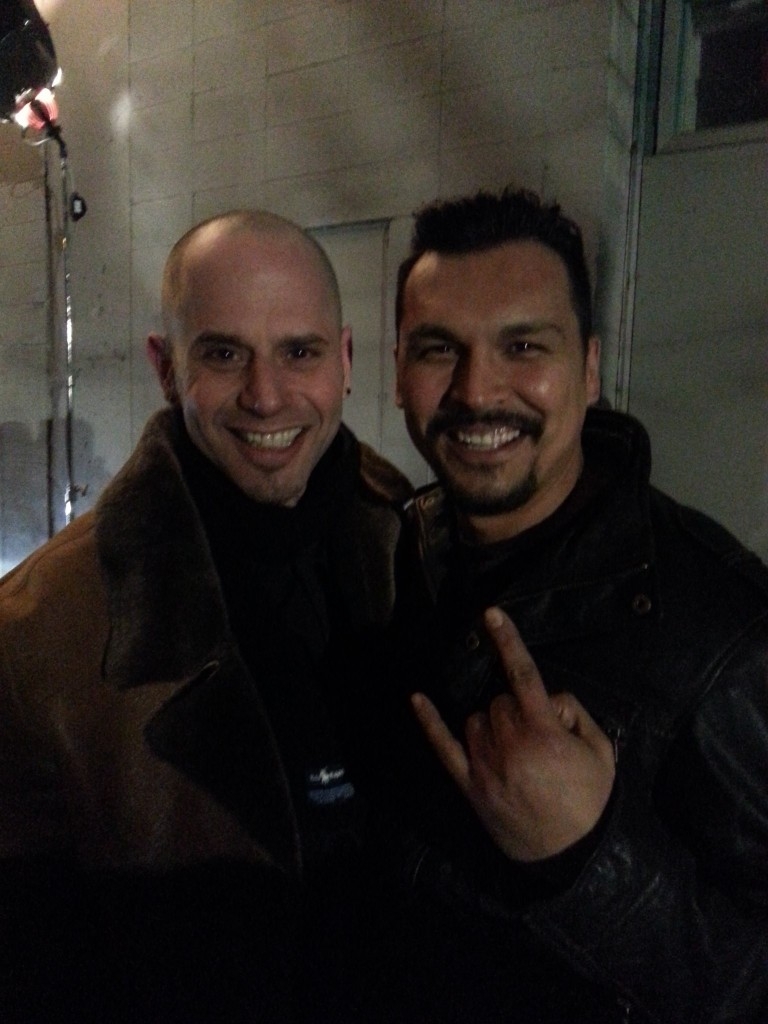
Overall, I had two shoot days originally scheduled. The trick to shooting a movie for most actors with regular day jobs is pretty simple: you use every free moment that you have left to do it. One of the trickiest things about shooting a movie like this is the size of the cast. Scheduling is a potential nightmare. Crook was shot mainly at night and on weekends, with actors, technical, and support crew agreeing to work for less than scale. Think about that for a second: when was the last time you went in to work for less than your regular wage? For me, this is one of the aspects of the film that I’m proudest of – the extent to which everyone involved believes in the project, and the fact that they would actually take a financial loss to do it. It’s a pretty amazing testament to how dedicated these people are in wanting to tell a story, and more importantly, to show the world the level of filmmaking now taking place in this city.
There’s an old saying in the film world: hurry up and wait. And being on set is often an exercise in endurance. Twelve to 16-hour shoot days are the norm. Everything with moviemaking is done piecemeal, and sometimes, depending on the shoot schedule and hundreds of other variables, is even shot backwards or out of context. Just setting up a shot can be a time-consuming affair, so making sure everything is set up correctly and quickly comes down to the technical crew on the project. Gaffers, lighting, sound, props, special effects, costumes, continuity – it all has to synchronize and flow together. And it’s an impressive thing to see. The crew on Crook were consummate pros, and are genuinely the kind of people who enjoy what they do, and that certainly makes it easier to get through the stickier bits when things just aren’t going according to schedule. And unfortunately, my first day of shooting was a bit of a casualty. So after standing outside in the dead of winter under an underpass that was owned, apparently, as clearly indicated by the spray-painted tag, by a gang member named Cholo the Rat-King… in an industrial complex off Preston Street for 12 hours, I ended up getting sent home the first day without filming a single line. Which was a blessing in that I eventually got to spend an extra day working on the set, but it was also a reminder of how filmmaking works. Still, time spent hanging out with your friends, shooting a movie, and firing off tons of guns is a pretty damn fun way to spend the night!
Day Two:
The interior scenes taking place in Deluca’s 1970’s retro-looking office went without a hitch. Day 2 included my two biggest moments in the film, namely my face-off with Detective Miller (Bill Lake), and my confrontation with mob lynchpin William Weaver (Guy Beuller), one of the shadier, creepier, characters in Crook. Both Lake and Bueller are strong, natural actors, making our takes in their respective scenes a tight, professional experience. One of the greatest gifts in a scene is when the other actor, in the vernacular, “gives” you something back, whether a reaction, a gesture or an inflection. It’s the “intangible” something that intensifies and strengthens the moment and the scene, and Lake and Beuller certainly gave me lots to work with. Another 12-hour day, and we were all certainly exhausted and spent, but it was definitely a good kind of tired!
Day Three:
My last day on set, unfortunately, happened to coincide with Ottawa’s last big snowstorm of the year. Coming straight from my workplace in the St. Laurent area, it took me nearly 90 minutes to get to the industrial complex where we were shooting. This was my last day on set, and the last shoot day, so pressure to get things right the first time was fresh in everyone’s mind. Tonight, we would shoot my penultimate scene, my bloody and just fate as a no-goodnik! And my anxiety in knowing that there was a crowd waiting for me to get there added a little anxiety and immediacy to my reaching the set. Once I finally arrived, I quickly changed into my wardrobe while sitting in my car and hustled to the location. So there we were – cast, crew, braving the storm, all tucked in behind an old warehouse and a portion of the OTrain track. To say it was uncomfortable in a weather-sense is a bit like saying that high-fructose corn syrup is only kind of bad for you; in other words, a bit of an understatement. With the wind chill, it was roughly minus 28 degrees that night. To be clear, it was so cold, that the Norse god Thor himself would have been like “Holy frick, it’s pretty damn cold! Forsooth and whatnot.” Now granted, he’d say it in Norse or spell it out with some runes or something, but you get my point. The only thing that helped was knowing that A) We’re all working on something that we love and believe in, B) At least my friends are here, and C) At least they’re as cold and miserable as I am. Obviously, I get pretty mean when I get cold and am surviving only on linty pocket candy.

But something strange and amazing happens when you spend substantial chunks of time with people, much less with friends you’ve known for years. When you sit in a car with someone for hours at a time, as anyone who’s ever gone on a road trip can attest, things can get a little… weird. Maybe it’s because you’re all confined in a tight, small space, literally inches from each other; maybe it’s the anxious excitement of wanting to do a good job; maybe it’s that almost palpable giddiness of feeling like you’re someplace you belong and doing what you love. Or maybe it’s because you’re dizzy from the constant release of a gas so foul that it would make a World War one vet keel over, by one of your more overly flatulent co-stars. Regardless, at one point the fatigue and goofiness take over. I have never had the kinds of conversations that I have on movie sets, outside of that environment. There’s something about it that brings down your guard and pretence. And while there were some conversations that would not be appropriate to retell here, suffice it to say, the four actors in the car that night really tried to tackle life’s deepest mysteries. Things like: “Seriously, what are marshmallows made of exactly?” or “How do snakes move so fast without legs?” or even “Do you think the inside of a kangaroo’s pocket would be soft or sticky?” You know, the really important questions.
Now, with the amount of gunfire we let loose that night, I’m sure we gave more than one nervous neighbour or OTrain passenger some cause for concern and a bad case of the sweats. Extremely loud, sustained and repeated bursts of automatic gunfire, dozens of folks yelling, actors dressed as SWAT team members, and extremely bright lights will do that to people. It was a little like that last scene in E.T. the Extra-Terrestrial where the Government is coming to nab the little fella, but with much, much more gunfire and foul language. This was it – the face-off between my character and Beech’s. The wind-up to the longest day and night of their lives, and one destined to be filled with a truckload of bullets. But high-intensity scenes like that one, with so many moving parts, stunts, people and gunfire, are tricky and delicate shots to get.
Action takes a lot longer to do, Langley confides. The scenes are shot in little bits and pieces, it takes longer to set up, and you need several cameras to film it correctly and make sure you get the coverage you need. Most productions get anywhere from 40 to 100 days to shoot an entire movie. We shot about nine pages a day on Crook.
By comparison, some big-budget movies and directors can sometimes spend months on one single page of script, never mind nine pages in one day.
Filmmaking is one of the most difficult things do in that it’s a collaborative effort. We had a crew of 14 on a shoot that should have taken 30 to 40 days, but because the budget and the timeline we had was so tight, that’s what we did, and because we had such amazing actors and crew, we were able to pull it off, Langley says. It was a tough shoot for sure, it was cold, and making a page-count that high was challenging. But the desire we all had was to accomplish something special. And our actors and crew showed great talent and tenacity; the collective community was able to raise the production to something we all wanted to see.
Langley shares a story about a director in town being asked what his favourite movie was. The director’s answer? “Any movie that actually gets made.”
So if it’s that hard to make a movie, if it’s there’s that much hardship and sacrifice required, why do it at all?
Partly, it’s the art itself, the sense of creative expression, the love of the process and of that medium of expression, and the fact that I don’t want to do anything else, Langley explains. Art is the biggest three-letter word there is, and it fuels the core, the engine of millions of people in the world. I think artists are artists on a genetic level. Animals build things for survival, but people build things for the creative sake of it, for the sense of completeness, connectedness and joy that it gives us. He adds: And where would we be without that? People love movies for what they give them, and that same love is also on the other side of the camera. Both sides of the camera love movies for the same reason, for what it gives them. It’s a selfish and selfless gesture all at the same time.
There’s something about creating art that bonds the one making with the one receiving, something that allows both parties to simultaneously experience the two sides of the coin, and that’s part of what makes it such an intimate experience. Bottom line, if you can find something that you like to do that much in life, something that lets you feel like that, even a little, you owe it to yourself to have it in your life. We all talk about wanting to find a place to belong, a place where we fit in. And acting not only provides that for me, but as importantly, it caters to my most basic and human need to play. Playing gets a bad rap a lot of the time, I think. There have actually been studies pointing to the necessity of play for a healthy psyche and spirit. But eventually we get older, and we’re told we need to leave behind the things we define as childish. So maybe that sense of play, that sense of fun, is a gift that we shouldn’t ignore or dismiss so easily; maybe it’s a gift that allows us to feel that purity of innocence, that blissful hopefulness and joy that we used to feel when we were kids, all over again.
And a special thanks to my agents Rachel, Kate, Christine and Laura, the wonderfully lovely folks over at the Mensour Agency, for all their continued hard work on my behalf and for their steadfast and sincere encouragement: http://www.
___________________________
*“Prop car” – Literally a car that was parked onset as a prop for the shoot

